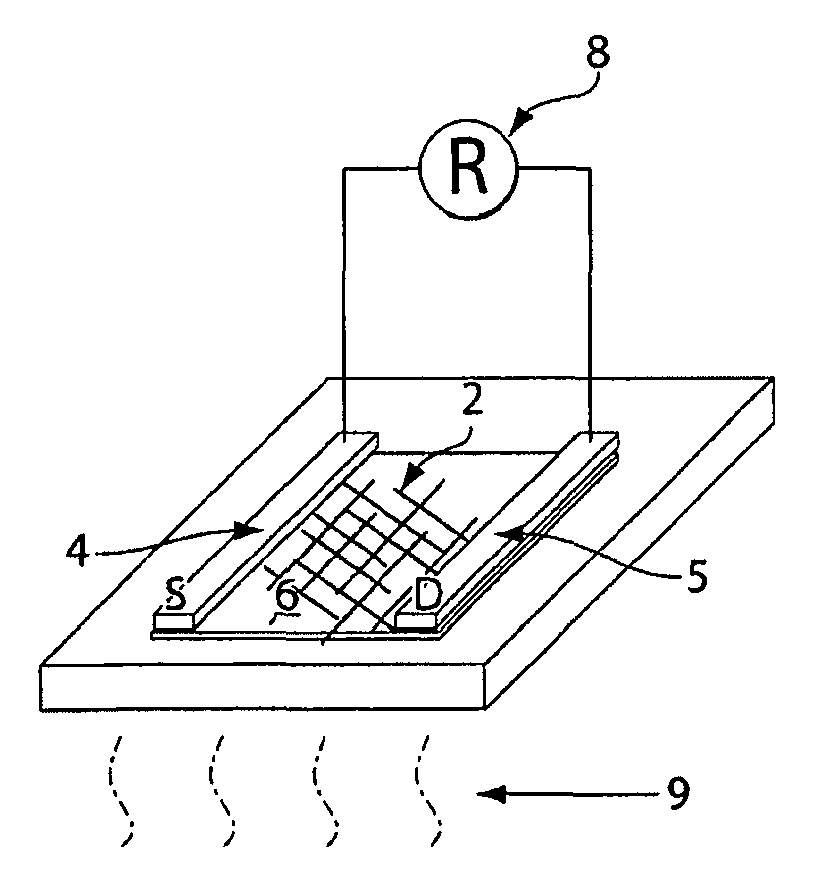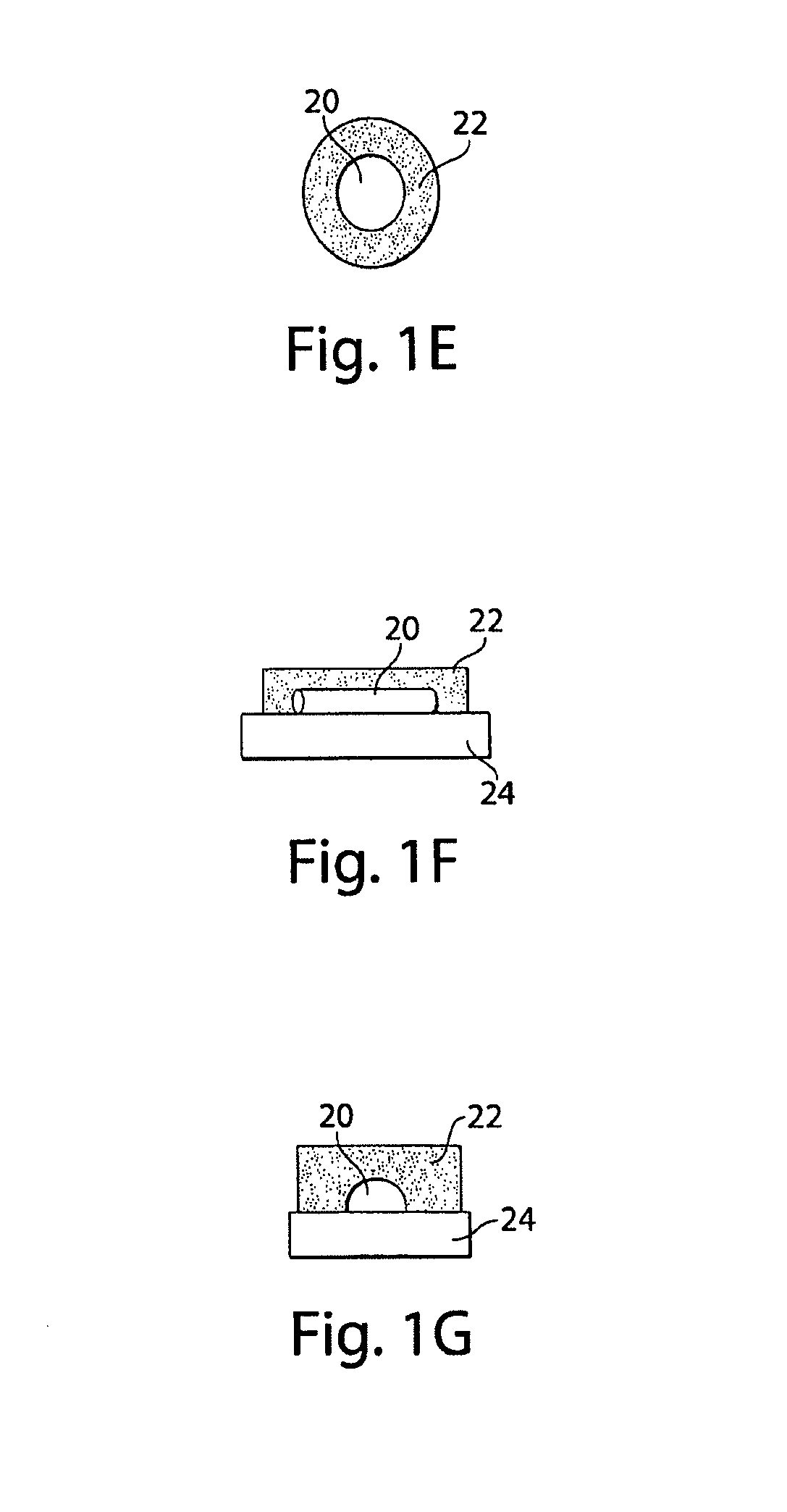Devices and methods for determination of species including chemical warfare agents
a technology of chemical warfare agents and devices, applied in the direction of liquid/fluent solid measurement, material electrochemical variables, instruments, etc., can solve the problems of poor sensitivity, high power consumption, and many current devices limited
- Summary
- Abstract
- Description
- Claims
- Application Information
AI Technical Summary
Problems solved by technology
Method used
Image
Examples
example 1
[0147]The following example describes the use of a sensor material including SWCNTs dispersed with a hexafluoroisopropanol functionalized polythiophene in the fabrication of a highly sensitive and selective chemiresistor sensor.
[0148]Stable dispersions of single walled CNTs (SWCNTs) were prepared by sonicating the SWCNTs in the presence 50 wt. % of a hexafluoroisopropanol substituted polythiophene (HFIP-PT) or poly(3-hexylthiophene) (P3HT). Polymer / SWCNT films (50 nm thick) were spin-coated from 0.2 wt. % solutions (THF for HFIP-PT and CHCl3 for P3HT) onto a glass substrate, and two gold strip electrodes (50 nm thick) were then sputter-coated onto the film. The resistance of HFIP-PT / SWCNT devices ranged from 0.5 to 1.5 MΩ. The quality of the dispersions may indicate that the CNTs form a percolative network of largely individual tubes.
[0149]A schematic view of the device is shown in FIG. 3A, wherein the device comprises a percolative network of carbon nanotubes 2 positioned between t...
example 2
[0156]This example reports the analysis of polymer / CNT sensor in which various binding sites were incorporated within a device.
[0157]To detect xylene isomers, a series of calixarenes of different conformation were mixed with P3HT and SWCNTs. The device was fabricated in a similar fashion as Example 1, with the binding site (e.g., a calixarene) being mixed with the polymer. FIG. 11A shows the three isomers of xylene, ortho-xylene 60, meta-xylene 62 and para-xylene 64. FIG. 11B shows the calixarenes that were investigated in this example, p-tert-butylcalix[4]arene (66), p-isopropylcalix[4]arene (68), and p-isopropyldihomooxa-calix[4]arene (70). The sensors were exposed to 400 ppm of xylenes. FIG. 12 shows the response of the sensors containing calixarene 66 shown in FIG. 12G when exposed to 400 ppm of xylene. FIGS. 12A, 12B, and 12C show the response of P3HT containing calixarene 66 to xylene isomers 64, 62 and 60, respectively. FIG. 12H shows the structure of P3HT. FIGS. 12D, 12E, an...
example 3
[0158]This example reports the analysis of polymer / CNT sensors in which a binding site has been added, specifically a palladium complex.
[0159]Binding sites for olefins were integrated into a sensor to improve the sensitivity of the sensor for olefin analytes. One such type of binding site that may be added to a sensor to increase selectivity for olefins is PtCl2(olefin)(pyridine). An example of how PtCl2(olefin)(pyridine) may associated with an olefin is depicted in FIG. 15A. As shown in FIG. 15B, PtCl2(ethylene)(pyridine) may be synthesized by reaction of K[PtCl3(ethylene) and pyridine. The device was fabricated in a similar fashion as Example 1, with the binding site (PtCl2(olefin)(pyridine)) being mixed with the polymer. FIG. 16A shows P3HT which was compared with P3HT containing the binding site (80). FIG. 16B shows the response of P3HT and 80 to an atmosphere of saturated hexene. The sensor containing P3HT (and no binding site) exhibits a response of 5% while the sensor contain...
PUM
| Property | Measurement | Unit |
|---|---|---|
| bias voltage | aaaaa | aaaaa |
| bias voltage | aaaaa | aaaaa |
| bias voltage | aaaaa | aaaaa |
Abstract
Description
Claims
Application Information
 Login to View More
Login to View More - R&D
- Intellectual Property
- Life Sciences
- Materials
- Tech Scout
- Unparalleled Data Quality
- Higher Quality Content
- 60% Fewer Hallucinations
Browse by: Latest US Patents, China's latest patents, Technical Efficacy Thesaurus, Application Domain, Technology Topic, Popular Technical Reports.
© 2025 PatSnap. All rights reserved.Legal|Privacy policy|Modern Slavery Act Transparency Statement|Sitemap|About US| Contact US: help@patsnap.com



